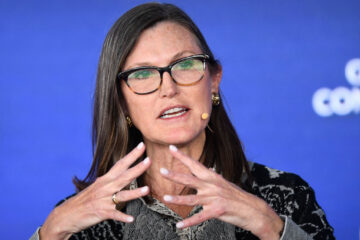After weeks of speculation, Vice President Kamala Harris, who is now the official Democratic presidential nominee, announced during a rally in Philadelphia this week that Minnesota Gov. Tim Walz will be her running mate.
Though the Democratic National Convention takes place in Chicago starting on Aug. 19, Walz is already under the microscope by netizens and the news media for his fairly progressive policy decisions as governor, including those regarding abortion rights, LGBTQIA+ issues, and free meals for schoolchildren.
However, compared to the Republican presidential ticket consisting of former President Trump and Senator J.D. Vance (R-OH), which has the support of Tesla (TSLA) CEO and internet troublemaker Elon Musk, Walz brings added strength to an otherwise hostile position on electric vehicles.
Democratic presidential candidate, Vice President Kamala Harris and Democratic vice presidential candidate Minnesota Gov. Tim Walz appear on stage together during a campaign event at Girard College on Aug. 6, 2024 in Philadelphia.
Andrew Harnik/Getty Images
Walz, the EV advocate
Walz is a strong advocate for electric vehicles, pushing initiatives and policy that would help contribute to the growth of electric vehicle adoptions in Minnesota during his tenure as governor.
In 2021, Walz pushed for Minnesota to adopt the California Air Resources Board’s (CARB) strict tailpipe emissions standards.
California’s rules are among the strictest in the nation. It would require sales of new zero-emission electric vehicles to comprise 35% of total vehicles sold in the state in 2026 and 100% by 2035.
“Minnesotans certainly know that old adage, ‘You need to skate where the puck is going to be,'” Walz said in 2021. “The puck is going to be in EVs. And that is irrefutable,”
Naturally, the governor faced backlash for advocating for EV rules that would nonetheless affect the kind of vehicles being sold in the state.
The final rules, which were tweaked from the original, were signed into Minnesota law in 2021 and took effect this year. The Minnesota rules established a goal of at least 20%, or 1 in 5 cars be electric-powered by 2030.
The Minnesota Auto Dealers Association, a coalition of the state’s auto retailers, complained about the ruling in a lawsuit, seeking to overturn it on the charge of regulatory overreach. The case escalated to the U.S. Supreme Court, which later decided in favor of the state.
Related: Trump’s VP pick is the EV industry’s worst nightmare
J.D. Vance, the gas-guzzler advocate
“Like all regular people I grew up with in the heartland, JD studied at Yale, had his career funded by Silicon Valley billionaires, and then wrote a best seller trashing that community,” Walz said during a Harris/Walz campaign event.
“And I got to tell you: I can’t wait to debate the guy. That is, if he’s willing to get off the couch and show up.”
If Vance actually gets off that couch and agrees to debate Walz, one of the hard-nosed topics on which they will disagree is EVs, which Vance has differing views on.
Though Vance is known for being a climate change denialist, he previously held views on the subject that other Republicans were afraid to express.
At a January 2020 conference hosted by the Center for Ethics and Human Values at Ohio State University, he recognized a “climate problem,” praised alternatives like solar power, and recognized natural gas as not “the sort of thing that’s gonna take us to a clean energy future.”
However, Vance’s direction changed once the money started coming in when he ran for the Senate. According to Open Secrets, a public website that tracks individual politicians’ campaign contributions, Vance has received $340,289 from the oil and gas industry since 2019.
More Business of EVs:
Porsche and Mercedes diverge at EV crossroadsA Fisker-type problem is affecting an automaker known for qualityPolice officer pulls over Waymo robotaxi, is greeted by no driver or passengers
Since then, he told an audience that he is “skeptical of the idea that climate change is caused purely by man,” praised the dirty practice of hydraulic fracking for extracting oil in the state of Ohio, and introduced a bill that would counteract EV sales with gas-guzzler sales.
In 2023, Vance introduced the Drive American Act, a bill that would remove the $7,500 EV tax credit funded by the Inflation Reduction Act and replace it with a subsidy of the same amount for American-made gas-guzzlers.
“Right now, the official policy of the Biden administration is to spend billions of dollars on subsidies for electric vehicles made overseas,” Senator Vance wrote.
“If we’re subsidizing anything, it ought to be Ohio workers – not the green energy daydreams that are offshoring their jobs to China. We can secure a bright future for American autoworkers by passing this legislation and reversing the misguided policies of the Biden administration.”
Related: Elon Musk’s endorsement inspired Trump’s sudden flip-flop on EVs
Walz, the car guy
Though Walz’s policies can characterize him as some sort of “environmentalist hippie” on the surface level, the now-VP pick has been cited as being a “car guy” by multiple outlets.
Like President Biden, Walz is also an automotive enthusiast.
As per the Autopian, his personal car is not a Prius or a battery-powered EV, but a blue 1979 International Harvester Scout, an off-roader that automotive historians have credited as the precursor to today’s modern SUVs.
You got a fast car
I’ve got a 1979 International Harvester Scout pic.twitter.com/LWEOHeHlU0
— Governor Tim Walz (@GovTimWalz) February 11, 2024
Walz’s dog is also named Scout. According to The Minneapolis Star Tribune, he “tinkers around” with the vintage off-roader in his spare time and, as an archived “get out the vote” video suggests, on other cars as well.
In a get-out-the-vote video, he criticizes Ford for using low-quality parts on the 2014 Ford Edge SUV and offers a solution that would’ve come from a true backyard mechanic.
A favorite from my Walz archive. pic.twitter.com/IXOzUnRne1
— Matt Wagenius (@mattwagenius) August 5, 2024
“This right here is the headlight harness on a 2014 Ford Edge,” he says to a handheld camera. “Ford, this is unacceptable. It burned out hot on the connector.”
Though Ford would suggest replacing the whole headlight, Walz suggests other Ford Edge owners buy a new connector and splice it together with some shrink-wrapping.
“It’s about a five-minute fix, and you’re back on the road safe and sound.”
Related: Veteran fund manager picks favorite stocks for 2024


